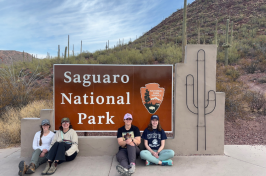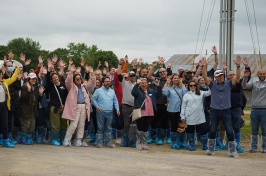UNH Scientist Helps Uncover How Disease is Transmitted Between Livestock

Bison in the greater Yellowstone area. Credit: Yellowstone National Park
DURHAM, N.H. - Using new molecular techniques, a team of scientists that includes University of New Hampshire researchers has shown how a largely eradicated livestock disease has been transmitted among cattle, bison, and elk in the greater Yellowstone area. The research may have important implications in the management of disease outbreaks between livestock and wildlife.
NH Agricultural Experiment Station researcher Jeffrey Foster, assistant professor of molecular, cellular, and biomedical sciences at UNH, worked with other scientists to investigate the wildlife-livestock transmission pathways of a disease called brucellosis, which often causes a termination of pregnancy in animals. The disease was unintentionally introduced to elk and bison in the greater Yellowstone area over the past century, likely through infected cattle. More recently, however, the disease is being transmitted from elk to cattle, undermining livestock control efforts.
"Bison were long believed to be the most important source of cattle infections of brucellosis, but we've found that elk are a surprisingly important component of the disease spread and maintenance in the Greater Yellowstone Area," said Foster. "We were trying to understand how this pathogen is moving around in the Yellowstone area. Which animals are its 'best' hosts and how are they dispersing it in the ecosystem? By learning this we can find ways to eradicate this important wildlife and livestock disease."
"Think about this type of disease research the next time you have milk in your cereal or eat a bite of cheese. Brucellosis is among the most important livestock diseases worldwide but has been largely eradicated in the United States through decades of livestock health programs by the USDA and state agencies. Our work uses new molecular techniques of genomics to precisely track the spread of a pathogen, Brucella abortus. The approaches we use can be applied to other pathogens to study newly emerging infectious diseases. Genomics can be a powerful tool for disease epidemiology," he said.
Scientists developed and analyzed a genomic dataset of Brucella abortus, the bacteria that causes brucellosis, which spanned 30 years and included samples from cattle, bison, and elk. The study examined the evolution, cross-species transmission history, and spread of the disease, which is found worldwide in humans and livestock. Results indicate five genetically distinct groups of strains of B. abortus in the greater Yellowstone area that are likely due to historic cattle introductions. Four out of the five strains are now primarily associated with elk and originated from the Wyoming feeding grounds, where state and federal land managers provide feed for elk in the winter.
Two of these elk-associated strains have spread at about 4 to 8 kilometers per year. Scientists conclude that elk are the most likely source of current brucellosis outbreaks in livestock. The fifth genetically distinct strain originated and was mainly found in bison of Yellowstone National Park. This strain appeared to be spreading less rapidly.
Previously, it was not known whether elk could sustain the disease in the absence of bison or supplemental feedgrounds. This study shows that elk, in some areas distant from the feed grounds, have strains that are unrelated to bison, suggesting that management of bison and feedgrounds may not affect brucellosis dynamics in these other elk populations, where the disease has been spreading.
In North America, the greater Yellowstone area is the last remaining reservoir of B. abortus. More than 20 cattle and farmed bison herds have been infected in Wyoming, Idaho, and Montana since 2002, and the presence of the disease within livestock results in additional testing requirements and trade restrictions. Eradication efforts have removed brucellosis in cattle in New Hampshire so the disease is not a current threat in the state.
This research is presented in the article "Genomics Reveals Historic and Contemporary Transmission Dynamics of a Bacterial Disease among Wildlife and Livestock" in the journal Nature Communications.This material is based upon work supported by the NH Agricultural Experiment Station, through joint funding of the National Institute of Food and Agriculture, U.S. Department of Agriculture, under award number 1007917, and the state of New Hampshire. The study is a collaborative effort between the USGS, Northern Arizona University, University of Montana, U.S. Department of Agriculture, U.S. Fish and Wildlife Services, Idaho Department of Fish and Game, Wyoming Game and Fish Department, Montana Fish, Wildlife and Parks, the National Park Service and the University of New Hampshire.
Founded in 1887, the NH Agricultural Experiment Station at the UNH College of Life Sciences and Agriculture is UNH's original research center and an elemental component of New Hampshire's land-grant university heritage and mission.
The University of New Hampshire, founded in 1866, is a world-class public research university with the feel of a New England liberal arts college. A land, sea, and space-grant university, UNH is the state's flagship public institution, enrolling 13,000 undergraduate and 2,500 graduate students.
PHOTOS AVAILABLE FOR DOWNLOAD
https://colsa.unh.edu/nhaes/sites/colsa.unh.edu.nhaes/files/media/images/yellowstonebison.jpg
Bison in the greater Yellowstone area. Credit: Yellowstone National Park
https://colsa.unh.edu/nhaes/sites/colsa.unh.edu.nhaes/files/media/images/yellowstoneelk.jpg
Elk in the greater Yellowstone area. Credit: Yellowstone National Park
Latest News
-
November 5, 2025
-
October 24, 2025
-
October 8, 2025
-
October 2, 2025
-
September 24, 2025















































